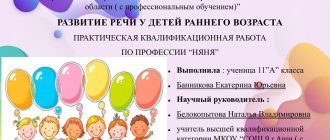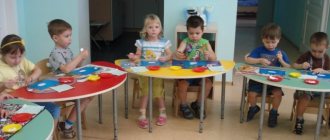Development of a child’s speech through different types of children’s activities
Lyudmila Eromova
Development of a child’s speech through different types of children’s activities
One of the leading tasks that preschool educational institutions solve, in the context of educational areas, is the development of children's speech .
Speech, as the leading means of communication, accompanies all types of child activity . his authority and status position on the quality of speech , the ability to use it in play, during joint activities between the teacher and the child , when planning and discussing a drawing, while observing a walk, when discussing a performance, etc. in the children's community .
The formation of correct speech is one of the main tasks of preschool education. However, a dynamic analysis of the practical situation over the past few years indicates an annual increase in the number of preschool children with speech disorders.
Today, figurative speech, rich in synonyms, additions and descriptions, in preschool children is a very rare phenomenon. Therefore, it is necessary to take care of the timely formation of children’s speech , its purity and correctness, preventing and correcting various violations, which are considered to be any deviations from the generally accepted forms of the Russian language.
Based on the above, the team identified the following tasks for speech development .
1. Enrich the cognitive-speech sphere of children with information through classes , observations, experimental activities , and speech.
2. Enrich emotional and sensory experience in the process of direct communication with objects, phenomena, and people.
3. Create conditions that facilitate the identification and maintenance of interests, the manifestation of independence in cognitive and speech activity .
4. Maintain conditions for the development of cognitive and speech processes of preschoolers in all types of activities .
In the practice of work of teachers, the following forms of work are used by type of educational activity .
— regime moments
- joint activities of the teacher and children
- independent activities of children
- joint activities with family .
The practical implementation of the specified system of work on speech development the child’s communicative competence .
Features of integration of educational areas in the speech development of preschool children .
Speech communication in preschool age is carried out in different types of activities : in play, work, household, educational activities and acts as one of the sides of each type. Therefore, it is very important to be able to use any activity to develop speech . First of all, speech development occurs in the context of leading activity . In relation to young children, the leading activity is object-based activity ; for preschool children, play activity .
to develop speech :
• communication between adults and children, development of communication skills;
• cultural language environment, teacher’s speech;
• teaching native speech and language in the classroom ;
• fiction;
• various types of art (fine, music, theater)
.
Speech development and communication activities
The most important means of speech development is communication . Speech, being a means of communication, arises at a certain stage in the development of communication . It does not arise from the very nature of the child , but is formed in the process of his existence in the social environment. Its emergence and development are caused by the needs of communication, the needs of the child’s life . Contradictions that arise in communication lead to the emergence and development of the child’s linguistic ability , to his mastery of ever new means of communication, forms of speech . This happens thanks to the cooperation of a child with an adult , which is built taking into account the age characteristics and capabilities of the baby.
An analysis of children's behavior showed that the presence of an adult stimulates the use of correct speech ; they begin to speak only in a communication situation and only at the request of an adult. Therefore, it is recommended to talk with children as much and as often as possible.
Communication with peers has a great influence on children’s speech, especially from 4–5 years of age. When communicating with peers, children more actively use speech skills. The greater variety of communicative tasks that arise in children’s business contacts creates the need for more diverse speech means .
Communication between children of different ages . Association with older children puts children in favorable conditions for the perception of speech and its activation : they actively imitate actions and speech , learn new words, master role-playing speech in games, the simplest types of stories based on pictures, and about toys. Thus, communication is the leading means of speech development . Its content and forms determine the content and level of children's speech .
Games aimed at developing communication skills
“Who came to us?”
,
“Say your name”
,
“Ball in a circle”
,
“Locomotive of friendship”
,
“Roll the ball and name it”
,
“Yes-yes and no-no”
,
“Find yourself a partner”
,
“Say hello!”
,
“We need to do this!”
,
“Give a smile to a friend”
,
“Recognize by voice”
The groups have a card index “ Development of communication skills ”
, where these and other games are presented.
Speech development and play activities
In preschool age, play is of great importance in the speech development of children . Its character determines speech functions, content and means of communication. All types of play activities are used for speech .
In a creative role-playing game, communicative in nature, there is a differentiation of functions and forms of speech . Dialogue speech is improved in it, and the need for coherent monologue speech . Role-playing play contributes to the formation and development of the regulating and planning functions of speech .
Outdoor games influence the enrichment of vocabulary and the development of sound culture. Dramatization games contribute to the development of speech activity , taste and interest in artistic expression, expressiveness of speech , artistic speech activity .
Didactic and printed board games are used to solve all speech development . They consolidate and clarify vocabulary, the skills of quickly choosing the most suitable word, changing and forming words, practice composing coherent statements, and develop explanatory speech .
Individual games different effects on children's speech development .
Role-playing games. Here the child uses expressive means of speech (intonation, volume, tempo, emotional coloring, onomatopoeia, etc.). He learns to plan the concept of the game, develop it , come up with the further course of events, look at the game situation from different positions , since he plays several roles.
In theatrical games, children act out plots and take on roles from literary works, fairy tales, cartoons, etc. Theatrical games contribute to a deeper understanding of the meaning of the works being played out and activate children’s speech.
In the process of construction-constructive games, children learn to observe, distinguish, compare, remember and reproduce construction techniques, and focus on the sequence of actions. Children learn how to make a building, learn to plan the work, presenting it as a whole, analyze and synthesize the building, and show imagination.
Children master the vocabulary, that is, speech is enriched, expressing the names of geometric bodies, spatial relationships, and dialogical speech develops
Didactic games occupy a particularly important place in this work, since cognitive content and mental tasks are a mandatory element in them.
During these games, develops depending on the direction of the game itself.
Experimental games are a special group of games that are very effective in solving cognitive and speech problems, and are also interesting and exciting for preschoolers.
As a result of children’s assimilation of cause-and-effect relationships, children’s vocabulary is enriched, grammatical structure improves, and coherent speech develops .
to develop a child’s speech without including it in some activity !
Speech development and cognitive research activities
Developing a child’s speech without including him in cognitive and research activities is impossible , since speech accompanies and improves the cognitive activity of children .
In the process of cognitive and research activities, the following tasks are solved:
— contribute to the enrichment of children’s active vocabulary through cognitive and research activities
— enrich the emotional and sensory experience of children in the process of direct communication with objects, phenomena, people
- develop a caring attitude towards the environment, consolidate positive emotions, and the ability to express them
— create conditions conducive to identifying and maintaining children’s interests, demonstrating independence in their cognitive and speech development
— maintain conditions for the development of cognitive and speech processes of preschool children in all types of activities
-involve parents in joint research and productive activities that contribute to the emergence of speech activity
Speech development and productive (artistic)
activity
Develops understanding of speech , teaches how to follow instructions. After a drawing class, for example, you can discuss the work, describe it, come up with a story about the object.
Speech development and musical activity
Singing training plays a particularly important role in speech development Conventionally, learning to sing takes place from three sides: work on breathing, work on diction and voice training.
Speech tasks are also solved together:
-improving the vocal apparatus for singing, at the same time improving for the speech of a preschooler ;
— a culture of expressive performance, which is necessary in singing, forms speech expressiveness;
— developing the skill of solo singing lays the foundation for monologue speech ;
- development of modal sense , musical intonation, opens the ability to speech intonations.
Perception of fiction
Children, being carried away by cartoons and TV series, mastering their far from literary, superficial language and style of presentation, children thus form their own speech. Reading fiction and Russian folklore will help avoid this. Then, from reading, various forms of work arise in which speech develops : learning poems, retelling, dramatizing fairy tales, etc.
In this way, children develop the ability to hear and understand speech, enrich their vocabulary, develop monologue speech and its intonation side, expressiveness.
Speech development and work activity
Through work activities dialogical speech , children's active statements are stimulated, a friendly attitude towards peers is formed, and the ability to work in pairs is formed. These tasks are solved during duty, observations, work assignments, during sensitive moments, etc. Communication in the process of work (domestic, outdoor, manual)
helps enrich the content
of children's ideas and speech , replenishes the dictionary with the names of tools and objects of labor, labor actions, qualities, and results.
Basic means of speech development
Direct educational activities
One of the main means of speech development is training . This is a purposeful, systematic and planned process in which, under the guidance of a teacher, children master a certain range of speech skills and abilities. The role of education in a child’s of his native language was emphasized by K. D. Ushinsky, E. I. Tikheeva, A. P. Usova, E. A. Flerina and others. E. I. Tikheyeva, the first of the followers of K. D. Ushinsky, used the term “teaching the native language”
in relation to preschool children.
She believed that “systematic teaching and methodical development of speech and language should form the basis of the entire system of education in kindergarten .”
The most important form of organizing speech and language teaching in the methodology is considered to be special classes in which certain tasks of children’s speech development .
Without special training sessions, it is impossible to ensure the speech development of children . In-class training allows you to complete the tasks of all sections of the program. There is not a single section of the program where there is no need to organize the entire group. The teacher purposefully selects the material that children have difficulty mastering and develops those skills and abilities that are difficult to develop in other types of activities .
Classes help realize the possibilities of speech development in preschool childhood , the most favorable period for language acquisition.
In the classroom, in addition to the teacher’s influence on the children’s speech, the children’s speech interacts with each other .
Team training increases the overall level of their development .
In our practice, integrative classes based on the principle of combining several types of children's activities and different means of speech development . As a rule, they use different types of art , the child’s independent speech activity and integrate them according to a thematic principle. For example: 1) reading a story about birds, 2) collective drawing of birds and 3) telling children stories based on drawings.
Speech development is also carried out in organized educational activities in other sections of the kindergarten . This is explained by the very nature of speech activity . The native language acts as a means of teaching other educational areas.
Fiction is the most important source and means of developing all aspects of children's speech and a unique means of education. It helps to feel the beauty of the native language and develops figurative speech .
Methods for developing coherent speech
There are several methods for developing coherent speech, they are described below.
Modern educational technologies
The development of coherent speech in preschool children means the improvement of dialogic and monologue speech forms. To do this, teachers must integrate the following technologies into their work:
- Game (speech exercises, communication exercises, games for fine motor skills, role-playing games, etc.).
- ICT.
- Mnemonics.
Using the fairy tale format for the development of speech in preschoolers
Mnemonics as a technique for developing coherent speech in preschoolers
Mnemonics is a technique that makes it easier to memorize words by forming associations. In mnemonics, information that is difficult for a child to understand must be replaced with a visual image. This technique promotes the development of imagination, visual memory, and associative thinking.
Important! In the development of coherent speech in preschoolers, specialists are required to use mnemonic tables.
An example of using a mnemonic table
Analysis map of GCD for speech development in preschool educational institutions according to the Federal State Educational Standard
The key to the successful development of a child’s speech culture lies in the correct planning and conduct of direct educational activities (DEA). To do this, teachers should keep GCD analysis cards with a pre-drawn up work plan, taking into account the specifics of children’s speech problems, identifying methods for their correction, and drawing up explanatory recommendations for working with children, including for parents.




